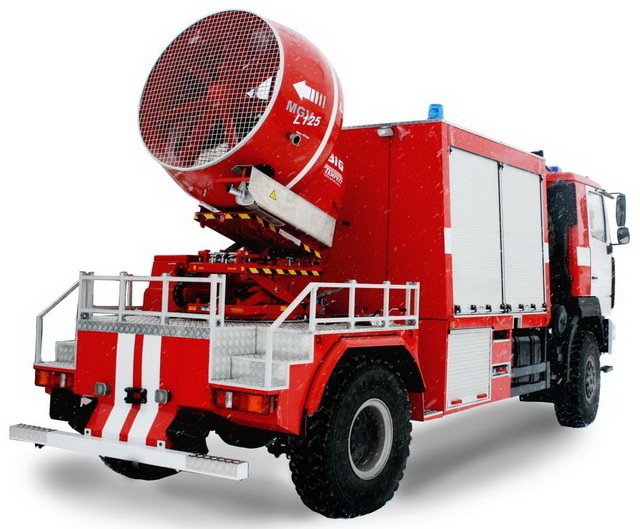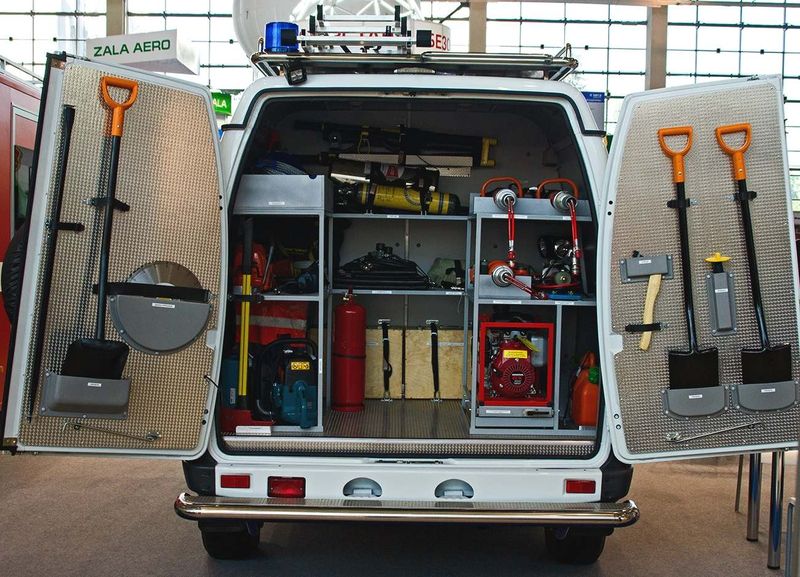9.3. Basic fire trucks
Basic fire trucks(OPA) - fire trucks designed to deliver personnel to the place of call, extinguish fires and carry out emergency rescue operations with the help of vehicles carried on them fire extinguishing agents and fire equipment, as well as for supplying fire extinguishing agents from other sources to the fire site.
Meeting your highest expectations. In a way, we are proud to embody some of the character traits of hardworking Finns, including the special spirit of this challenging sector and the great tenacity of our commitment. This way you can use the most reliable, safe and efficient air devices, guaranteeing the best ranges both vertically and horizontally.
When they're not saving lives, these features are also highly valued in other challenging areas. Our vehicles can be used in many applications, such as optimal acquisition of television images for a Formula 1 race or golf tournament, or to facilitate afternoon cleaning of space shuttles.
The main fire trucks, depending on their primary use and areas of operational activity, are divided into firefighting vehicles general applications and PA target applications.
Basic fire trucks general
fire tankers.
fire tanker trucks with ladder (if the number of combat positions is more than 3 people).
Generally, our fire trucks are known for their compact design, which improves their maneuverability in difficult and demanding conditions. At the destination, the compact design provides operators with fast and optimal access to the target area. Thanks to modern technological equipment, the implementation of equipment is carried out smoothly and without any special training. Even the highest air hand, which reaches 112 meters, works in a few minutes. This may be critical to planning the next operation or course of action.
fire fighting tankers with articulated lift (if the number of combat positions is more than 3 people).
fire and rescue vehicles.
fire rescue vehicles with ladder.
first aid fire trucks.
fire pump-hose vehicles.
fire trucks with high pressure pump.
Basic fire trucks target Applications depending on the type of transported fire extinguishing agents and the method of their supply are classified into the following types:
In this way, they can approach the target and, if necessary, quickly move away from any source of potential danger. The rescue unit is equipped with built-in outlets for water, air, hydraulics and electricity. Accessories such as a wheelchair or stretcher are also available, which can be useful when caring for the elderly, disabled or injured, and the high maximum load capacity allows for a large number of people to be accommodated. once in a rescue container.
With us, you can maintain and even develop your firefighting and life support capabilities in long term. Besides high level customization and reliable one-time supplies, we can guarantee the availability of your equipment. fight fire with comprehensive control of them life cycle. In addition, a wide range of training options are available to ensure efficient and safe operation of both machines and operators.
powder extinguishing fire trucks.
foam extinguishing fire trucks.
combined extinguishing fire trucks.
gas extinguishing fire trucks.
Fire trucks for gas-water extinguishing.
fire pumping stations.
Firefighting foam lifters.
airfield fire trucks.
9.4. Tactical and technical characteristics of the main fire fighting vehicles for general use
9.4.1. Fire tankers.
Fire tanker(AC) - a fire truck equipped with a fire pump, containers for storing liquid fire extinguishing agents and means of supplying them and designed to deliver personnel, fire-technical weapons and equipment to the site of a fire, carry out fire extinguishing operations and rescue operations.
Table 80
Technical characteristics of operated fire fighting tankers
(Soviet period)
|
Indicators |
(model 42B) |
ATs-40 (130E) (model 126) |
ATs-40 (130) (model 63A) |
ATs-40 (130) (model 63B) |
ATs-40 (131) (model 137) |
ATs-40 (131) (model 153) |
ATs-40 (133G1) (model 181) |
ATs-40 (375) (model 94) |
ATs-40 (EDMU1L (model PM 102A) |
|
Maximum speed, km/h | |||||||||
|
Number of seats for combat crew, including driver | |||||||||
|
Weight with full load, kg | |||||||||
|
Smallest turning radius, m | |||||||||
|
Fuel consumption per 100 km, l | |||||||||
|
Fuel tank capacity, l, | |||||||||
|
Water supply at suction height 3.5 m, l/min | |||||||||
|
Capacity, l: water tank, foam concentrate tank | |||||||||
|
Water suction time from a height of 7 m, s | |||||||||
|
Foam mixer capacity, m 3 /min |
Light fire fighting tankers
Table 81
Technical characteristics of modern light fire fighting tankers
|
Characteristic |
All-wheel drive |
All-wheel drive |
||
|
AC 0.8-4 (5301 FB) |
AC 1.5-30/2 (5301) |
AC 1.5 5-40/4 (5301) | ||
|
ZIL-5301FB (4×4) |
ZIL-5301FB (4×4) |
ZIL-5301FB (4×2) |
ZIL-5301FB (4×2) |
|
|
Engine power, l. With. | ||||
|
Maximum speed, km/h | ||||
|
Water foaming agent | ||||
|
Number of seats for combat crew, people. | ||||
|
NTsPK 40/100- 4/400 |
NTsPK 40/100-4/400 | |||
|
Pressure, m water. Art. | ||||
|
Feed, l/s | ||||
|
Suction height, m | ||||
|
Overall dimensions, mm, no more: | ||||
|
Total weight, kg | ||||
Medium fire fighting tankers are designed to deliver combat crews, a supply of fire extinguishing agents, fire-fighting equipment, water supply (from a tank, open reservoir, hydrant) and air-mechanical foam to the fire site to the fire site.
Table 82
Technical characteristics of medium fire tank trucks
|
Indicators |
All-wheel drive |
All-wheel drive |
||||||||||||
|
ATs-40 (131) 1-CHT |
AC 2.5-40 (131N) |
ATs 3-40/4 (4325) |
ATs 3-40 (4326) |
AVD 20/200 (4331-04) |
AC 3.0-40/4 (4331-04) |
AC 3.0-40 (4331-04) |
ATs 4-40 (4331-04) |
|||||||
|
ZIL-131 (6×6) |
ZIL-131 (6×6) |
ZIL-131 (6×6) |
Ural-4325 (4×4) |
KamAZ -4326 (4×4) |
Ural-43202 (6×6) |
KamAZ -43101 (6×6) |
ZIL-433 (4×2) |
ZIL-433104 (4×2) |
ZIL-433104 (4×2) |
ZIL-433104 (4×2) |
ZIL-433104 (4×2) |
|||
|
Engine power, l. With. | ||||||||||||||
|
Maximum speed, km/h | ||||||||||||||
|
Supply of fire extinguishing agents, l: foaming agent | ||||||||||||||
|
Number of unpaid places, people. | ||||||||||||||
|
NTsPN -40/100 |
NTsPK 40/100-4/400 | |||||||||||||
|
Pressure, m.v.st. | ||||||||||||||
|
Feed, l/s | ||||||||||||||
|
Suction height, m | ||||||||||||||
|
Overall dimensions, mm, no more: | ||||||||||||||
|
Total weight, kg | ||||||||||||||
Heavy fire fighting tankers are designed to deliver combat crews, a supply of fire extinguishing agents, fire-fighting equipment, water supply (from a tank, open reservoir, hydrant) and air-mechanical foam to the fire site to the fire site.
Table 83
Technical characteristics of heavy-duty fire-fighting tank trucks
|
Characteristic |
All-wheel drive |
All-wheel drive |
||||||||
|
ATs 5-40 (4925) |
ATs 5.0-40 (4310) |
ATs 6.0-40 (5557) |
ADC 6/6-40 (5557-10) |
ATs 8.0-40 (5557) |
ADC 8/6-40 (55571-30) |
ATs 8.0-40/4 (4320) |
ADC 9/3-40 (55571-30) |
ATs 6.0-40/4 (5321-1) |
ATs 7.0-40 (53213) |
|
|
KamAZ -4925 (4×4) |
KamAZ -4310 (6×6) |
Ural-5557 (6×6) |
Ural-5557-1152-10 (6×6) |
Ural-5557-1152-10 (6×6) |
Ural-5557 (6×6) |
Ural-4320 (6×6) |
Ural-55571-30 (6×6) |
KamAZ -53211 (6×4) |
KamAZ – 53213 (6×4) |
|
|
Engine power, l. With. | ||||||||||
|
Maximum speed, km/h | ||||||||||
|
Supply of fire extinguishing agents, l: foaming agent water | ||||||||||
|
Number of combat crew seats, people. | ||||||||||
|
NTsPK 40/100-4/400 | ||||||||||
|
Pressure, m.v. Art. | ||||||||||
|
Feed, l/s | ||||||||||
|
Suction height, m | ||||||||||
|
Overall dimensions, mm, no more: | ||||||||||
|
Total weight, kg | ||||||||||
According to statistics, the most dangerous moment for people during a fire is its consequences. Combustion products, ceiling collapses and the like cause major damage to health. Therefore, in such situations, it is advisable to use equipment of a special design and purpose. Special fire trucks are primarily designed to save people.
Types of special equipment
Special fire trucks transport personnel and are equipped with firefighting equipment, but the main thing in them is special means and installations. Most of these vehicles have tanks, tanks for fire extinguishing agents and the necessary communications for them. Superstructures are placed on the chassis of a truck, since the weight of the equipment requires reliable and stable support.
Special vehicles must provide:
- removal of combustion products;
- work at height;
- lighting;
- disassembly building structures;
- ensuring access to fires;
- evacuation of people;
- first aid for victims.
Is not full list, but the main functions to ensure operation fire department are displayed in it. Depending on the equipment and methods of use, special vehicles are divided into several groups. Like basic fire trucks, they come in light, medium and heavy duty. Most of these vehicles are universal and work in residential, public and industrial facilities. They are assigned to fire departments or units of the Ministry of Emergency Situations.
The requirements for the exterior coincide with other types of fire fighting vehicles and equipment. To do this, use 2 colors - red and white. > the main task special vehicles - prompt response and execution of work; they can be distinguished from main vehicles by equipment.
AL
Firefighting ladders are vehicles on a chassis with a large load capacity, high maneuverability and an extended wheelbase. This design solution allows them to be used in urban environments and beyond. However, ladder trucks must move normally in populated areas with dense buildings, because it is in such places that fires in high-rise buildings often occur.
The main equipment is a fixed rotating ladder that extends. It allows you to deliver firefighters and fire extinguishing equipment to heights, carry out evacuation and rescue work. Sometimes it is used as an observation post, for installing equipment at certain points at a height and securing lighting fixtures. Stationary ladders can be used to move cargo.
Cars of similar design are divided into types according to the height of the extended ladder. For most aerial ladders, this figure is 30 m. Models are equipped with cradles or an elevator, but there are options without them. The elevator is designed for quick evacuation of people or delivery of fire equipment. They are also fixed on stairs fire monitors, if provided for by the design.
agro-industrial complex
By design Articulated car lifts are very similar to fire truck ladders. The base, chassis and fixed part are identical. Instead of a ladder, a retractable boom is installed. It can be rotary cranked or telescopic. At the extreme link of the boom there is a platform (cradle). There are restrictions on the inclination of the surface on which a working car lift stands - no more than 3º. Maximum speed winds up to 10 m/s.
Car lifts of this type deliver a load of fire extinguishing agents and substances, firefighters to the site of fires, or are used to carry out rescue operations. Operational evacuation is not carried out using articulated car lifts. To control the mechanisms, a remote control is provided, which is located on the platform or in another similar place. Car lifts can handle loads of more than 400 kg.
AR
Hose vehicles are necessary for laying fire hoses and extinguishing fires. They are used as auxiliary equipment in conjunction with fire pumping stations and others. The cabin of the hose car can accommodate 3 people. Behind it there is equipment and compartments for it. The cross-country ability of such a vehicle is high, since it is often used for fire extinguishing major fires in hard-to-reach places.
The main function is to deliver fire hoses to the fire extinguishing site; their total length in one vehicle reaches 2-5 km. In the compartments, the sleeves are folded, on the side of the superstructure or on the sides. An additional benefit from traction power is the ability to pull out stuck vehicles and equipment using a durable and long winch.
DU
 Smoke extraction vehicles are used to remove smoke in large rooms, including basements, in elevator shafts, stairwells. With the help of a fan unit, not only ventilation and suction of combustion products are carried out, but it is also possible to form air-mechanical foam to extinguish or contain the flame.
Smoke extraction vehicles are used to remove smoke in large rooms, including basements, in elevator shafts, stairwells. With the help of a fan unit, not only ventilation and suction of combustion products are carried out, but it is also possible to form air-mechanical foam to extinguish or contain the flame.
The cabin carries several personnel. Fire tankers can additionally be used to generate and transfer high-expansion foam. The vehicle smoke exhaust device is designed to work with large volumes of gas-air mixtures and high temperatures– over 300ºС. A hydraulic motor is provided for the operation of the fan unit. The fire superstructure of this special vehicle has compartments for portable smoke extraction systems.
GDZS
Each piece of equipment with gas and smoke protection functionality is assigned to the relevant departments gas and smoke protection service. The gas and smoke protection service vehicle ensures the delivery of combat crews, equipment and means, carrying out rescue operations and safe extinguishing fire. Used at petrochemical industry facilities, industrial plants and other similar facilities. The number of cars in a service unit depends on the population in a particular city or locality. This is stated in the rules.
The equipment of a firefighting vehicle for the gas and smoke protection service includes electrical equipment, lighting devices, a control system, power plants, and fire-fighting equipment.
Tools must be included in the kit personal protection, since the work is carried out in conditions of heavy gas pollution.
Many models are equipped with telescopic masts with lighting fixtures (spotlights) on them. Gas and smoke protection service vehicles are designed on the basis of a chassis with high cross-country ability and large load capacity. Additional equipment - tools for working with building structures (chips), electric saws and smoke exhausters.
ASA
Emergency rescue vehicles are designed to carry out emergency rescue operations, illuminate the area, provide first aid medical care. They are used not only by fire departments, but also rescue units Ministry of Emergency Situations.

Depending on their purpose and equipment, fire rescue vehicles are light, medium and heavy. The first ones are based on the chassis of lightweight transport models and are necessary for fast delivery personnel and minimum set equipment to the fire site. The latter are fully equipped, and their firefighting superstructures are installed on a heavy-duty chassis. The equipment of third vehicles includes optional equipment for dismantling rubble, dismantling building structures and their elements and lifts.
Emergency rescue vehicles are also used for reconnaissance of the radiation situation, liquidation emergency situations With technological equipment. The equipment set for medium and heavy modifications includes smoke exhausters, radio stations, lighting equipment, and winches.
AS
Staff vehicles are based on passenger cars and semi-truck chassis. There are models based on buses. Staff vehicles are necessary to ensure the full operation of the fire extinguishing headquarters and the delivery of combat crews to the site of fires. Additional functions– radio communication with departments and service center.




